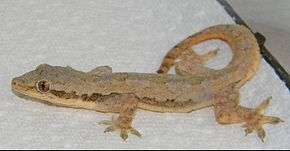Definify.com
Webster 1913 Edition
Gecko
Geck′o
(gĕk′ō̍)
, Noun.
pl.
Geckoes
(gĕk′ōz)
. [Cf. F. & G.
gecko
; – so called from the sound which the animal utters.] (Zool.)
Any lizard of the family
Geckonidæ
. The geckoes are small, carnivorous, mostly nocturnal animals with large eyes and vertical, elliptical pupils. Their toes are generally expanded, and furnished with adhesive disks, by which they can run over walls and ceilings. They are numerous in warm countries, and a few species are found in Europe and the United States. See Wall gecko
, Fanfoot
. Definition 2025
Gecko
gecko
gecko
See also: Gecko
English

A female common house gecko (Hemidactylus frenatus)
Alternative forms
Noun
gecko (plural geckos or geckoes)
- Any lizard of the family Gekkonidae. They are small, carnivorous, mostly nocturnal animals with large eyes and adhesive toes enabling them to climb on vertical and upside-down surfaces.
- 1839, William Rhind, “Reptiles”, in Elements of Zoology; Embracing a View of Life as Manifested in the Various Gradations of Organized Beings, Edinburgh: Fraser & Crawford; John Anderson, Junior; and Maclachlan & Stewart; Smith, Elder, & Co. and H. Washbourne, London; W. Curry, Junior, & Co. Dublin, OCLC 33223559, pages 85–86:
- Order II. Sauria. […] The heart has two auricles. The body is covered with scales, and there are three or four feet. The lungs are large, and extend along the back. The mouth is armed with teeth, and the toes with claws. The tail is long, and often thick at the base. […] Geckotida—geco
- 1931, Proceedings of the Royal Society of London: Biological Sciences, volume 108, London: Royal Society of London, OCLC 856550794, page 456:
- Leishmania infantum in Experimental Animals.—Experiments were carried out with geckoes, white mice, field mice (Microtus güntheri) and hamsters (Cricetus auratus and Cricetulus griseus).
- 1962, Maurice Burton, “Geckoes”, in The Illustrated London News, volume CCXL, number II, London: Illustrated London News & Sketch Ltd., OCLC 424200096, page 548:
- GECKOES constitute a family of lizards remarkable for the large number of species it contains. They are also remarkable for a number of other features: for the readiness with which they have taken to living in houses, for their voices, the structure of their feet, the variation in the shape of the tail and for their eyes. […] As with the more familiar lizards, geckoes have the ability to cast the tail, and counts show that in some species two out of every five individuals have cast the tail and regenerated a new one.
- 1975 September 27, Colin Tudge, “How Gekko gecko defies gravity: A careful anatomical study of geckoes, those extremely agile climbing lizards, reveals an extraordinary degree of adaptation of the foot bones and muscles”, in New Scientist, volume 67, number 968, London: New Science Publications, OCLC 761620626, page 696:
- Many lizards, including the British common and sand lizards of the family Lacertidae, clamber over rocks with great agility; none matches the geckoes, some of which can run up, down, or across vertical glass as easily as most beasts run on the flat, and indeed can happily traverse ceilings.
- 1988, Uttar Pradesh District Gazetteers: Aligarh, volume 20, Lucknow, Uttar Pradesh, India: Government of Uttar Pradesh, OCLC 7625267, page 15:
- Other reptiles found in the district are the chamaeleon, geco and monitor lizard, the last getting extinct due to netting and shooting. It is now protected by law.
- 2009 January, Ginel Corina Hill, “Introduction”, in Dual-axis MEMS Force Sensors for Gecko Adhesion Studies (unpublished Ph.D. dissertation), Stanford, Calif.: Stanford University, OCLC 930874491, page 1:
- The marvelous ability of geckos to run down trees, surefooted and head first, was first noted by Aristotle over two thousand years ago. However, Aristotle was not able to see the tiny hairs, called setae, that cover the toes of geckos and empower this feat. The setae are part of an adhesive system that allows geckos to maneuver on a wide variety of substrates, to run upside-down, and to arrest their falls. Geckos can run vertically at over 1 m/s and can carry over twice their body weight up smooth, vertical surfaces.
- 2014, Wil Mara, From Gecko Feet to Adhesive Tape (Innovations from Nature), Ann Arbor, Mich.: Cherry Lake Publishing, ISBN 978-1-62431-752-1, pages 21–22:
- The potential uses for gecko-inspired adhesive products are nearly endless. People have found possible uses for them from sports and robotics, to medicine and home improvement.
- 2016, Martyn Robinson, Australian Wildlife after Dark, Clayton, Vic.: CSIRO Publishing, ISBN 978-1-4863-0072-3:
- By day, Golden-tailed Geckoes rest under curls of bark, the underside of branches, or in tree hollows but they seem to be fond of heat so these geckoes may even be in a situation where the sun shines on their daytime retreat all day. The Golden-tailed Gecko is an invertebrate-eater and by night its adhesive toe pads allow it to prowl the branches of Brigalow trees with ease, looking for small insects and spiders to capture.
-
Translations
lizard of the family Gekkonidae
|
|
Synonyms
Derived terms
Terms derived from gecko
|
|
|
Verb
gecko (third-person singular simple present geckos, present participle geckoing, simple past and past participle geckoed)
- (rare) To move in the manner of a gecko; to attach to a vertical or upside-down surface.
- 2006 October, Peter Watts, Blindsight, New York, N.Y.: Tor Books, Tom Doherty Associates, ISBN 978-0-7653-1964-7, page 344:
- An emergency handpad, geckoed to the expanding bulkhead, slid past to one side. Sarasti grabbed it and tapped commands.
- 2009, Wendelin Van Draanen, The Gecko & Sticky: The Greatest Power, New York, N.Y.: Alfred A. Knopf, ISBN 978-0-375-84377-8, page 33:
- And as Dave geckoed his way along the walls, he began seeing more and more skid marks left behind by Damien's Sewer Cruiser.
-